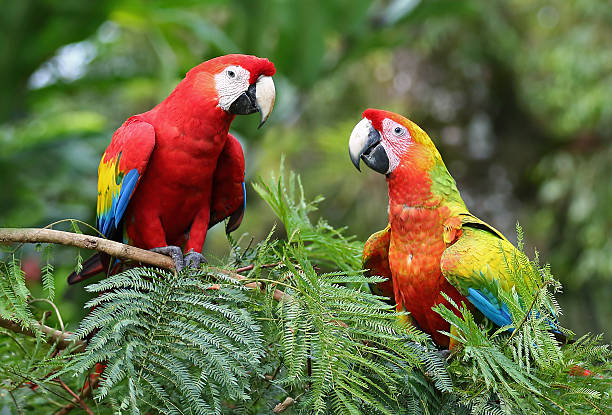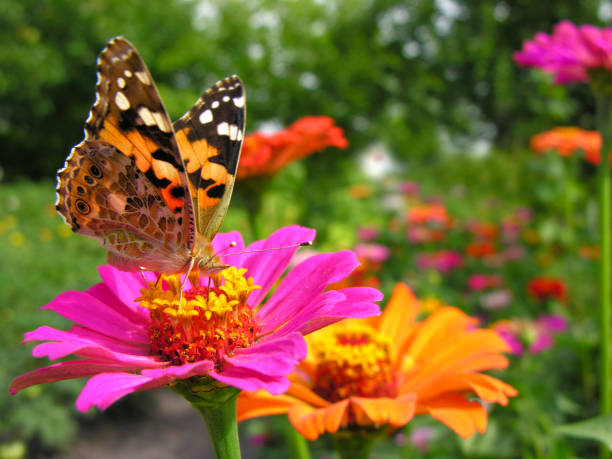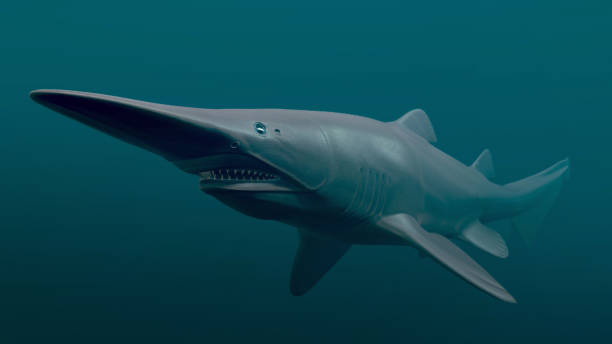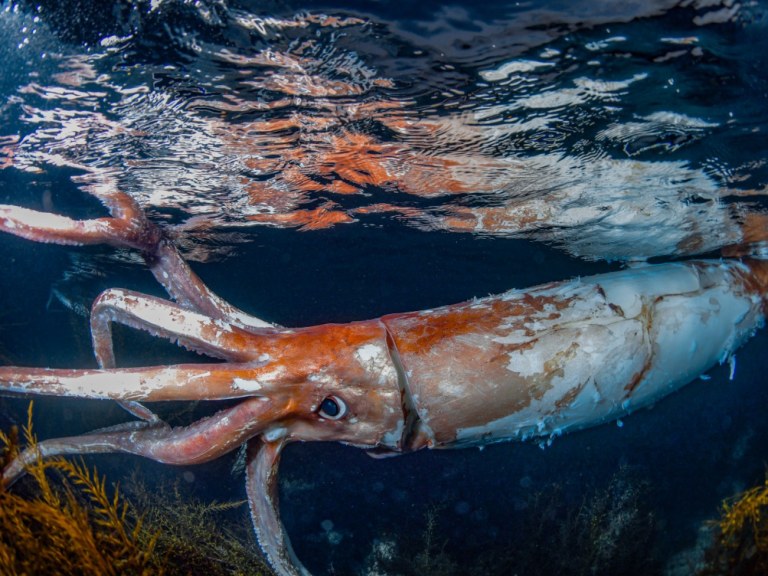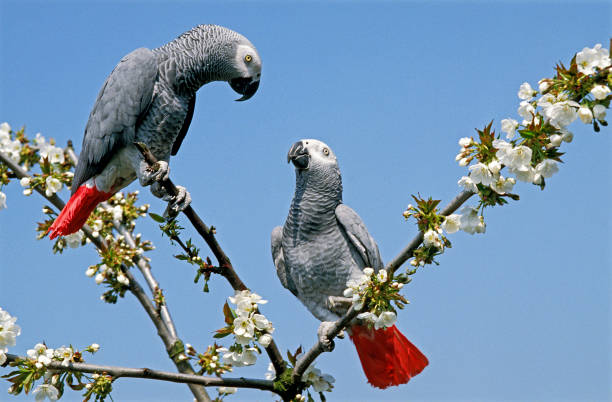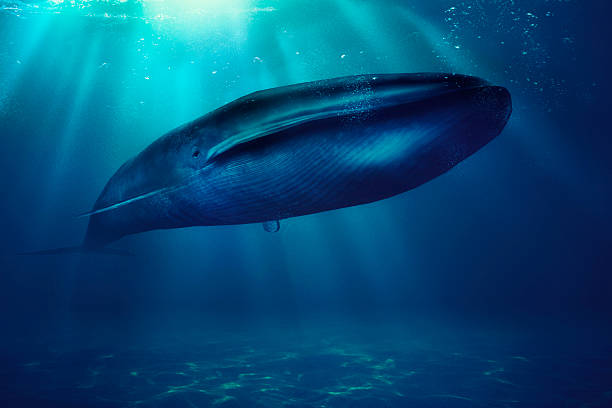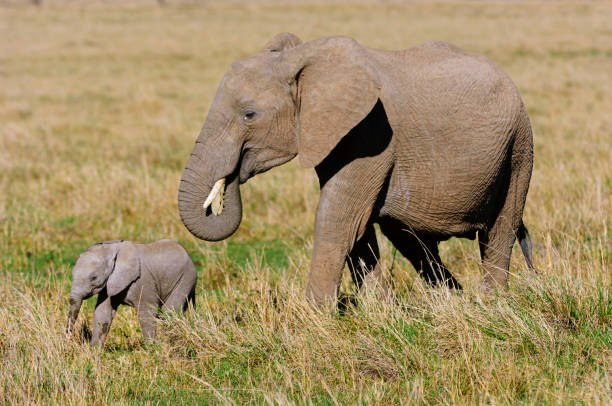Nature is the greatest artist the universe has ever known. From the deep blues of the oceans to the fiery reds of sunsets, the natural world is a palette of endless color. Yet nowhere is this artistry more breathtaking than in the plumage of birds. Across mountains, jungles, and coral islands, birds wear the sky’s spectrum on their feathers—living, breathing masterpieces of evolution.
Each colorful feather is a story written by time. Some shimmer to attract a mate; others warn predators or blend into a flowered forest. Every hue, every iridescent gleam, carries a secret of survival and beauty. In this vivid journey, we explore fifteen of the most colorful birds in the world—creatures so astonishing they seem painted by dreams.
1. Scarlet Macaw – The Flame of the Rainforest
Few creatures capture the soul of the tropics like the Scarlet Macaw. Native to the lush rainforests of Central and South America, this parrot blazes through the canopy like a streak of fire. Its feathers burn with crimson red, fading into brilliant yellow and cobalt blue on its wings and tail.
The Scarlet Macaw is not only beautiful but fiercely intelligent. It mates for life, and pairs are often seen flying side by side, calling out with loud, raucous voices that echo through the jungle. Its colors serve both as camouflage among bright tropical fruits and as a display of health and vitality to potential mates.
These birds have long been symbols of passion and freedom. To watch one in flight is to witness living sunlight—a being painted in the wild’s most vivid imagination.
2. Resplendent Quetzal – The Jewel of the Cloud Forest
In the misty cloud forests of Central America, the Resplendent Quetzal moves like a ghost wrapped in emerald silk. Revered by ancient civilizations like the Maya and Aztec, the quetzal was considered a sacred messenger between gods and humans.
Its feathers shimmer with iridescent green and blue, and males grow extraordinary tail plumes that can exceed two feet in length. When sunlight filters through the canopy, their feathers change color, appearing golden, turquoise, or even violet.
These shy birds are notoriously difficult to see, preferring high, dense branches where fruit is abundant. Their diet, rich in wild avocados, helps sustain the ecosystem—each seed they drop gives rise to new forest life.
The Resplendent Quetzal is not just a bird; it’s a symbol of freedom and spiritual beauty, an embodiment of nature’s sacred artistry.
3. Indian Peafowl – The Monarch of Elegance
When a peacock unfurls its tail, time itself seems to pause. Native to the Indian subcontinent, the Indian Peafowl is one of nature’s most extravagant displays of beauty and pride. The iridescent blues and greens of its plumage shimmer like gemstones, while the tail’s “eyes” hypnotize with their intricate symmetry.
Male peafowls fan their feathers during courtship, creating an almost celestial display. The colors come not from pigments but from microscopic crystal-like structures in the feathers that reflect and refract light—a phenomenon called structural coloration.
Peacocks have long symbolized immortality, royalty, and beauty across cultures. They walk with regal grace, their every movement a slow dance of shimmering color. In their elegance, we find the essence of nature’s grandeur.
4. Rainbow Lorikeet – The Flying Spectrum
If rainbows could sing, they would sound like the chatter of Rainbow Lorikeets. Native to Australia and nearby islands, these medium-sized parrots are explosions of red, green, blue, orange, and yellow. Their feathers seem to glow with an inner light.
Rainbow Lorikeets feed primarily on nectar and pollen, using specialized brush-tipped tongues to lap up sweetness from flowers. They travel in noisy, joyful flocks, their colors flashing like sparks against the blue sky.
Their bold hues serve both attraction and identification, allowing them to recognize mates and flock members among the kaleidoscope of the rainforest. In flight, they are living rainbows, streaking across treetops with uncontainable energy.
5. Wilson’s Bird-of-Paradise – The Jewel of Indonesia
Deep in the rainforests of Indonesia’s islands, Wilson’s Bird-of-Paradise performs one of the most mesmerizing dances in the natural world. This tiny bird is a masterpiece of evolutionary design—its colors are so vivid they seem unreal.
Its head is bald and turquoise blue, with a cross-shaped pattern of black lines. The body gleams with scarlet, yellow, and neon green, while two spiraling tail feathers curl elegantly like ribbons.
Males clear patches of forest floor for their courtship displays, meticulously removing debris to create a stage where their colors can shine. When the female arrives, he dances in circles, fanning his feathers in a dazzling performance of life and light.
Wilson’s Bird-of-Paradise is not just colorful—it’s a living sculpture of perfection, the rainforest’s ode to desire and artistry.
6. Keel-Billed Toucan – The Rainbow-Billed Wonder
With its enormous, multicolored bill, the Keel-Billed Toucan looks as though it were painted by a child’s dream. Native to Central and South America, this bird’s beak glows in shades of lime green, orange, red, and blue. Despite its size, the beak is surprisingly light, made of a spongy protein called keratin.
The toucan’s plumage is primarily black with a bright yellow throat and chest. In the rainforest, its brilliant bill flashes through the leaves like a beacon of joy.
Toucans are social and playful, hopping from branch to branch in small groups and tossing fruit to one another. Their colorful beaks help attract mates and possibly regulate body temperature.
Few sights are as enchanting as a Keel-Billed Toucan resting against a backdrop of green leaves and golden sunlight—a living symbol of tropical exuberance.
7. Gouldian Finch – The Rainbow Gem of Australia
The Gouldian Finch looks like a tiny jewel come to life. Native to northern Australia, it glitters with every color imaginable—red, purple, green, yellow, blue, and black. Each individual has unique variations, giving the species a kaleidoscopic diversity.
Their faces may be red, black, or yellow, while the rest of their plumage shimmers with iridescent hues. During breeding season, their colors become even brighter—a display of vitality and health.
Gouldian Finches are delicate and sensitive to environmental changes. Once endangered due to habitat loss, conservation efforts are helping them recover. Their beauty serves as both a reminder and a warning: nature’s colors are fragile gifts that must be protected.
8. Mandarin Duck – The Floating Masterpiece
In the still waters of East Asia’s lakes and ponds, the Mandarin Duck drifts like a living painting. Males wear a costume of astonishing intricacy—violet chest, golden-orange “sails” on their backs, green and white stripes across the face, and a crimson bill.
Mandarin Ducks are symbols of love and fidelity in Chinese culture, as they are known to form lifelong pairs. When two glide side by side on a mirror-like pond, their reflections double the magic.
Their color patterns are so complex that even after centuries of study and admiration, no two seem exactly alike. In their quiet elegance, Mandarin Ducks remind us that love, like color, can exist in infinite shades.
9. Lilac-Breasted Roller – The Sky’s Brushstroke
Africa’s open savannas are home to one of the most breathtaking birds on the continent—the Lilac-Breasted Roller. With its turquoise wings, lilac chest, and streaks of emerald, cobalt, and violet, it looks like it has flown out of a dream.
Rollers are known for their spectacular aerial displays. During courtship or territorial defense, they perform acrobatic dives and rolls—hence their name—flashing their brilliant plumage against the vast sky.
Their colors serve as camouflage in the bright African light, blending perfectly with both the sky and the flowers. To watch a Lilac-Breasted Roller soar above the savanna is to see nature’s brush paint the air itself.
10. Spangled Cotinga – The Turquoise Dream of the Amazon
Hidden deep within the Amazon rainforest, the Spangled Cotinga glimmers like a gem among emerald leaves. Males boast a dazzling turquoise-blue body with a crimson throat patch that gleams like a ruby in sunlight. Females, though duller, carry a subtle elegance with their soft brown tones.
Cotingas feed mainly on fruit, their colors acting as a beacon to others of their kind in the dense canopy. Scientists believe the vivid blue of the male is not pigment-based but structural, created by microscopic feather structures that refract light.
To catch sight of one in the wild is a rare privilege. They perch high above the forest floor, where sunlight can strike their feathers and awaken their color in flashes of pure magic.
11. Painted Bunting – The Feathered Rainbow of America
In the woodlands of the southern United States, the Painted Bunting appears like a spark of fantasy. Males wear a brilliant mix of blue heads, red underparts, and green backs—a combination so vivid it looks unreal.
Birdwatchers often describe their first encounter as unforgettable. The male’s plumage is among the most striking in North America, yet these birds are shy, preferring to stay hidden among dense foliage.
Females and juveniles wear softer green feathers, allowing them to blend with their surroundings. During breeding season, males sing melodious songs from exposed branches, their voices as colorful as their feathers.
The Painted Bunting is a living kaleidoscope, proof that even the smallest birds can carry the heart of a rainbow.
12. Violet-Backed Starling – The Amethyst Bird
Also known as the Plum Starling, the Violet-Backed Starling shimmers like polished amethyst. Found across sub-Saharan Africa, males glow with deep violet iridescence over their backs and heads, contrasting with pure white underparts.
The colors change depending on the light, shifting from purple to indigo to metallic blue. Females, though brown and streaked, are elegant in their own subtle way.
Violet-Backed Starlings often travel in pairs or small flocks, filling the air with soft whistles. Their feathers are not only stunning but also reflect sunlight in complex ways, making them nearly luminous during flight.
In the sun, their beauty is almost surreal—a reminder that color is nature’s way of singing silently to the heart.
13. Scarlet Tanager – The Red Flame of the Forest
Hidden among the green canopy of North American forests, the Scarlet Tanager glows like a single ember in the shadows. Males are a blazing red with jet-black wings and tails, while females wear olive-yellow tones that blend into the leaves.
During migration, Scarlet Tanagers journey thousands of miles between North and South America, carrying their fiery brilliance across continents. Their coloration is caused by carotenoid pigments from their diet, mainly insects and fruits.
Though small and elusive, their presence is magnetic. When sunlight catches a Scarlet Tanager perched in the trees, the entire forest seems to hold its breath.
14. King Bird-of-Paradise – The Ruby Dancer
Tiny but dazzling, the King Bird-of-Paradise from New Guinea is a masterpiece of miniature perfection. Males wear a deep crimson body, bright white chest, and two elongated tail feathers tipped with emerald-green disks that shimmer like jewels.
Their courtship dances are legendary. Males swing upside down on a perch, spread their wings, and display their tail plumes in rhythmic motion, creating an ethereal spectacle.
The King Bird-of-Paradise’s colors are the result of both pigment and light interference, producing an almost supernatural glow. In their display of passion, these birds embody the wild’s endless creativity.
15. Nicobar Pigeon – The Metallic Heir of Extinction
The Nicobar Pigeon, found on islands across Southeast Asia, is a living relic—the closest living relative of the extinct dodo. Yet while the dodo was plain, the Nicobar Pigeon is breathtaking. Its feathers shimmer in metallic shades of emerald, bronze, and copper, giving it a regal appearance.
When sunlight hits its plumage, the bird appears to glow from within. These pigeons live on remote islands, feeding on seeds and fruit, and their beauty seems untouched by time.
Their iridescent feathers serve as camouflage amid sun-dappled foliage, proving that beauty in nature is never just for admiration—it’s always for survival.
The Science of Avian Color
The brilliance of bird plumage comes from two main sources: pigments and structure. Pigments like melanin and carotenoids create blacks, browns, yellows, and reds. Structural coloration, on the other hand, comes from microscopic feather structures that bend and scatter light, creating shimmering blues, purples, and iridescent hues.
Many of the world’s most colorful birds—like peacocks, quetzals, and starlings—owe their hues to this phenomenon. Their feathers don’t actually contain blue pigment; instead, the light itself becomes the color, a miracle of physics and biology working in harmony.
Color also has deep evolutionary meaning. It can signal health, attract mates, or provide camouflage. The more vivid the plumage, the stronger the message: “I am thriving. I am alive.”
The Emotional Power of Color in Nature
Color in birds doesn’t just please the eye—it stirs the soul. It connects us to something ancient and universal: the human fascination with beauty as a symbol of life’s vitality.
When we see a peacock unfurl its tail, a macaw streak through the jungle, or a quetzal glimmer in misty light, we feel awe—an emotion that reminds us how small and miraculous our world truly is.
These birds embody what humanity has always longed for: freedom, creativity, and connection. Their colors tell stories not only of evolution but of emotion—the joy of existence expressed in the language of light.
A World Painted in Feathers
From the scarlet fires of the macaw to the sapphire dreams of the quetzal, the world’s most colorful birds are living proof that beauty is not an accident—it is life’s celebration of itself.
Every feather, every hue, is a testament to resilience and wonder. In a time when the natural world faces threats like deforestation and climate change, these birds remind us that the planet’s palette is precious and irreplaceable.
To preserve their colors is to preserve the poetry of the Earth itself. For when the sky fills with wings painted by nature’s own hand, we are not just seeing birds—we are witnessing the living art of creation.
